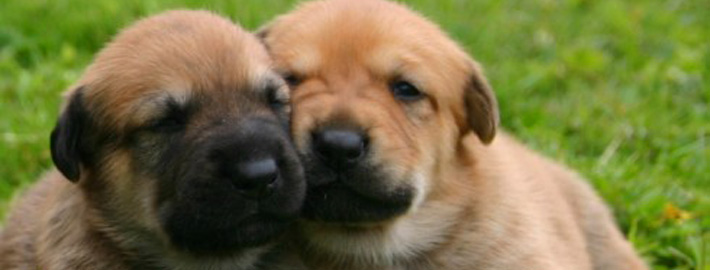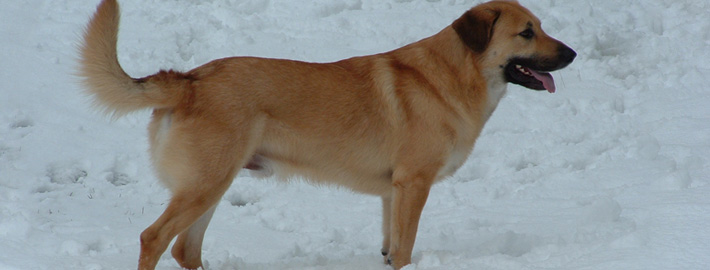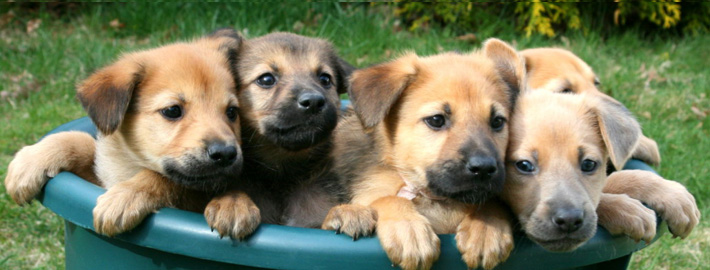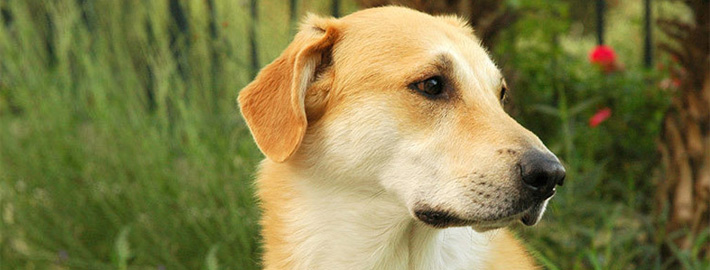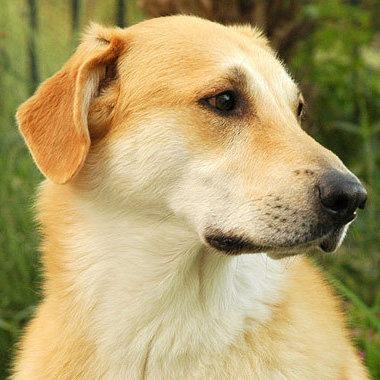What makes the Chinook Unique?
Created in the White Mountains of New Hampshire, the Chinook dog breed made his name on Admiral Byrd’s first Antarctic expedition in 1928. These days he’s a multipurpose dog who’s happy hiking, competing in agility and other dog sports, pulling a sled or other conveyance, and playing with the kids.
Breed Groups
Page Contents
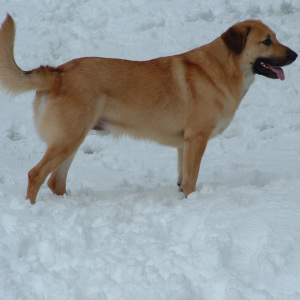
SnapShot
| Size: | Males – 58 to 69 cm (23 – 27 inches) Females – 53 to 64 cm (21 – 25 inches) |
| Weight: | Males – 25 to 41 kg (55 to 90 pounds) Females – 25 to 41 kg (55 to 90 pounds) |
| Origin: | United States |
| Life Span: | 10 to 13 years |
| Colour: | Double coat is “tawny” in color, with darker shadings on muzzle and ears; white dogs are not allowed, nor are other colors. |
| Litter Size: | 9 to 11 puppies |
Is the Chinook Right For You?
The Chinook is a playful, eager to please family companion that loves children. Highly trainable, adaptable, and versatile, the breed thrives on regular exercise and activities such as backpacking, hiking, jogging, agility, and skijoring. Chinooks are not a protection breed and do not make good guard dogs. His thick coat will shed seasonally and requires regular brushing and bathing.
In 5 Words
- Alert
- Friendly
- Calm
- Dignified
- Intelligent
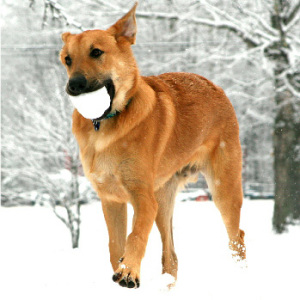
Characteristics
Learn About the Chinook
Description
Derived from a single ancestor, the Chinook breed came from a dog named Chinook, which was one of three puppies born to a Northern Husky female bred with one of Peary’s North Pole dog team. The father was a large mixed breed dog, and Chinook did not really resemble either one of his parents. Compact with a muscular frame, the Chinook has a well-balanced body. The powerful muzzle of this breed features strong teeth that meet in a scissors bite. The black nose has large, wide nostrils. The almond-shaped eyes of brown or amber color are moderate in size and offer an expression of intelligence. The Chinook has a compact muscular frame that well suits this gentle sled dog.
The body is well balanced; the chest is deep; moderate bone and flexible musculature are prominent. The skin on the head is tight with no wrinkles. The stop is moderate and there is a furrow running vertically from the stop to the occiput Standing 21 to 27 inches (53 to 69 cm) in height at the withers and weighing 55 to 90 pounds (25 to 41 kg), the Chinook is balanced and muscular. The United Kennel Club (UKC) breed standard states that “The ideal coloration runs from light honey color to reddish-gold. Black markings on the inside corners of the eyes are preferred. Dark tawny to black markings on the ears and muzzle are preferred.
Short History of the Chinook
The Chinook were first described by Lewis and Clark, who visited them in 1805, though they had been known to traders for at least 12 years previously. Lewis and Clark estimated their number at 400, but referred only to those living on Columbia River. The Chinook owes its existence to one man: Arthur Treadwell Walden of Wonalancet, New Hampshire.
The breed derives principally from one male ancestor born in 1917, named “Chinook,” who was Walden’s lead dog and stud. Chinook grew to be 100 pounds. In Walden’s book Harness and Pack, Walden described Chinook as “a large tawny yellow dog, a half-bred Eskimo, with dark ears and muscle. Chinook was known not only as a wonderful sled dog, but also for his gentle disposition toward children. Arthur Treadwell Walden of Wonalancet, New Hampshire created the Chinook dog around 1917.
Temperament
Dedicated and loyal, the Chinook is a calm dog with a good disposition. It is not aggressive with other dogs because it has been bred to work as part of a team. It will usually also do quite well with other family pets. This breed may occasionally be reserved around strangers, especially if it is in unfamiliar surroundings. These are dedicated, hard-working and versatile sled dogs. Performing their given task is their primary concern in life. In addition to sled-pulling, the breed also can be used for carting, obedience, flyball, search and rescue, and packing. Very friendly, calm, non-aggressive, dedicated and hard-working. The Chinook dog loves people including strangers and children. Usually great with other pets and other dogs.
Caring for Your Chinook
General Health
The following health conditions have occurred within the overall Chinook breed: excessive shyness, eye abnormalities, hip dysplasia, hormonal skin problems, mono/bilateral cryptorchidism, seizures and spondylosis. Health issues include normal hereditary problems such as epilepsy, hip dysplasia, and atopy. Also common is cryptorchidism, which occurs in about 10% of all male dogs.
Major concerns: none
Minor concerns: excessive shyness, eye abnormalities, hip dysplasia, hormonal skin problems, mono/bilateral cryptorchidism, seizures and spondylosis
Occasionally seen: none
Suggested tests: eyes, hip
Grooming & Bathing
The coat of the Chinook practically takes care of itself and requires little to no grooming. Chinooks have a double coat consisting of a downy undercoat and a course overcoat. Some Chinook owners have reported their dogs shed twice a year for about a week; otherwise, they shed very little. Others have reported their dogs to shed heavily all year round.
Exercise & Training
Chinooks adapt well to family life and prefer to accompany their “pack” on outings such as hiking or camping. They do not like to be left alone! Long periods of time without their family can lead to destructive behavior. Also, if left outside, they may attempt to dig under a fence.
Although they are working dogs, Chinooks require little activity. They are happy to go along on long walks or hikes, but they are just as content to nap on the couch. And remember that you have the power to protect your Chinook from one of the most common health problems: obesity. Keeping him at an appropriate weight is a simple way to extend your Chinook’s life.

